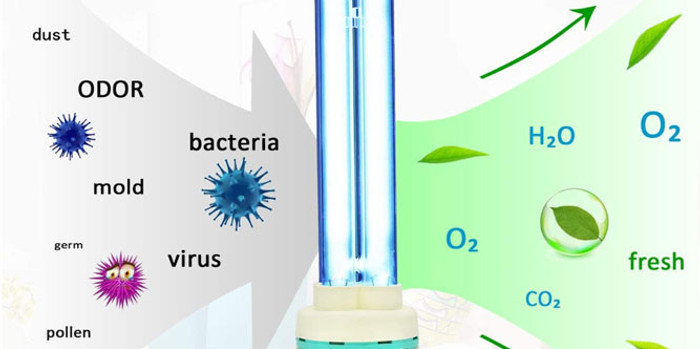All About Uvc Light
All About Uvc Light
Blog Article
Getting My Uvc Light To Work
Table of ContentsThe Single Strategy To Use For Uvc LightThe smart Trick of Uvc Light That Nobody is DiscussingGetting The Uvc Light To WorkUvc Light Things To Know Before You Get ThisFacts About Uvc Light RevealedUvc Light - An Overview
A brand-new type of ultraviolet light that may be secure for people took much less than 5 minutes to lower the level of indoor air-borne microbes by even more than 98%, a joint research by scientists at Columbia University Vagelos University of Physicians and Surgeons and in the U.K. has located. Even as germs continued to be sprayed right into the room, the level continued to be very reduced as lengthy as the lights were on.Till now these research studies had actually just been performed in small experimental chambers, not in full-sized spaces simulating real-world conditions. In the existing study, scientists at the University of St. Andrews, University of Dundee, College of Leeds, and Columbia College tested the efficacy of far-UVC light in a big room-sized chamber with the exact same air flow rate as a normal home or workplace (concerning three air changes per hour).
The effectiveness of different techniques to lowering interior infection degrees is generally measured in regards to equivalent air changes per hour. In this study, far-UVC lamps produced the equivalent of 184 equivalent air exchanges per hour. This surpasses any other approach to disinfecting occupied indoor spaces, where 5 to 20 equal air adjustments per hour is the ideal that can be attained almost.
Some Of Uvc Light

The major criteria of UV-C sanitation are wavelength, dosage, family member humidity, and temperature. There is no agreement concerning their ideal values, but, generally, light at a high dosage and a range of wavelengths consisting of 260 nm is liked in an atmosphere at room temperature level with reduced family member humidity. This light can be generated by mercury-vapour, light-emitting diode (LED), pulsed-xenon, or excimer lights.
Likewise, there are wellness and safety and security dangers related to the UV-C technology when used in the closeness of people. UV-C disinfection systems have promising attributes and the possible to improve in the future. Clarifications bordering the different criteria influencing the modern technologies' efficiency in hospital setting are needed. Consequently UV-C disinfection need to currently be considered for low-level instead of top-level disinfection.
One more application arose in 1910 when UV light was utilized to decontaminate water. However, the modern technology was not really reputable at the time and it took further technological advancements prior to UV water disinfection became prominent again in the 1950s [ 2] Nowadays, see this website UV light is made use of for water, air, food, surface, and medical equipment disinfection.
The smart Trick of Uvc Light That Nobody is Talking About
This results in the interruption of DNA or RNA, leading to the inactivation of the micro-organism. UV-C-induced DNA interruption often is composed of the bonding of two adjoining thymine (or cytosine) bases instead of the standard linking of a base with its corresponding base on the other hair.

Dark fixing, on the other hand, requires several enzymes and nutrients for energy [6] It is necessary to know whether last inactivation results have actually taken into account the event of resurgence given that it might cause 60% of the accomplished inactivation being reversed [7] Mutations can emerge upon UV-C exposure considering that this exposure can result in the origination of intra-strand cyclobutyl-pyrimidine dimers in DNA [ 6] The UV-C zone is utilized for sanitation yet there is no consensus on the exact ideal wavelength. Light at 260 nm can trigger the most disturbance. Numerous micro-organisms are most vulnerable to slightly different wavelengths.
The smart Trick of Uvc Light That Nobody is Talking About
On the other hand, it has technological ramifications because the read complete energy of the light beam is after that divided over all existing wavelengths. A micro-organism that is susceptible to 254 nm light will be suspended more by a light that gives off solely light at 254 nm than a lamp that discharges a wavelength spectrum at equivalent total power.
Exposure times of 1045 minutes for room sanitation and 25 s to 5 min for medical equipment were come across in literature. The strength is inversely symmetrical to the settled range between the source of light and the surface and is consequently specified at the surface in the dosage calculation formula [14]
Better, the output of a lamp lowers over time, so it is suggested to compute the dose at the end of lamp life, which is rep of a worst-case scenario. The dose likewise affects the amount of photoreactivation. Quek et al. found that the portion of photoreactivation lowered from 5.31% to 0% for an increase in dose from 1.6 to 19.7 mJ/cm2 [8]
The influence of temperature depends on the light source.
Some Known Questions About Uvc Light.
.jpg)

This is recognized as much UV-C innovation and is a fairly brand-new sanitation approach with restricted knowledge concerning its efficiency.
In research study, the outcomes on pulsed versus constant UV-C sanitation efficiency differ. When comparing pulsed and constant light it is important to keep various other variables such as wavelength and dose consistent.
Indicators on Uvc Light You Need To Know
In situation ozone is not needed for sanitation, a customized lamp can be official source made use of. For mercury-vapour lamps, drugged quartz glass or specialized soft glass can filter out short-wave UV-C light - uvc light.
Report this page